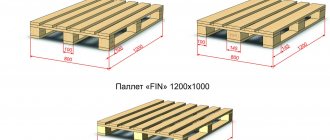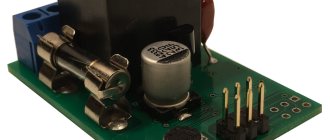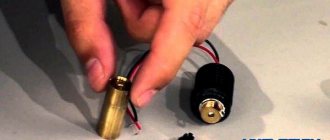In this video lesson, the “E+M” channel talked about what an electromagnet is. He also showed how to make it by hand with a supply voltage of 12 volts and performed a series of experiments using it. Showed how to increase efficiency.
First, a little theory of history. In the early 19th century, Danish physicist Oersted discovered the connection between electricity and magnetism. A current passing through a conductor located next to the compass deflects its needle towards the conductor. This indicates the presence of a magnetic field around the conductor. It also turned out that if you wind a conductor into a coil, its magnetic properties will increase. In a coil of wire, the so-called solenoid, magnetic lines are formed, the same as in a permanent magnet.
Depending on which side we carry the coil to the compass, it will deviate in one direction or another. Since two poles have formed in the coil: north and south. It is possible to change the direction of electric current when the poles are reversed. For the experiment, the author of the channel wound 2 identical coils. The first coil is 260 turns, resistance 7 ohms. 2 is twice as much. 520 turns, resistance 15 ohms. Power will be supplied from a DC source. Voltage 12 volts. In this case, it is a computer power supply. A lead-acid battery will also work.
Let's start experiments with the first coil, which has 260 turns. The multimeter is set to current measurement mode. It will show the current in amps flowing through the coil. As you can see, the indicator is 1.4 amperes. This is enough to attract small metal objects. Let's try a larger object. Let it be an iron ruble. The coil cannot handle this load. Let's try the same experiment with the second coil. The current here is 0.7 amperes. This is 2 times less than 1. At the same voltage of 12 volts. She also cannot attract the ruble. What can we do to increase the magnetic properties of our coil? Let's try to install an iron core. To do this we use a bolt. Now it will act as a magnetic circuit. The latter promotes the passage of magnetic flux through itself and increases the corresponding properties of the solenoid. Now our design has turned into an electromagnet. He can already handle the ruble with ease. The current remained the same, 1.4 amperes.
Let's experiment further and see how many of these objects the magnetic coil can attract. The electromagnet has heated up, which means its resistance has increased. The higher the resistance, the lower the current. The less magnetic field the coil creates. Let's let the electromagnet cool completely and repeat the experiments. This time the load will be 12 coins. As you can see, the lower coins began to fall off on their own as the current decreased. No matter how much the presenter tried to experiment, he managed to raise no more than this load.
Let's carry out the same experiment with the second coil. It has twice as many turns. Let's see if it is stronger than the previous one. Watch the continuation of the 12 volt electromagnet in the video from 6 minutes.
izobreteniya.net
Legality of the apparatus
GOST No. 50577-93 establishes requirements for the quality of coverage and readability of license plates installed on vehicles. In particular, this legal act prohibits changing the letters and numbers printed on the sign by changing its design.
License plates must be made in such a way that such changes would result in their destruction or significant deformation.
Despite the fact that installing a magnet does not entail deformation or destruction of the number, in this case the principle of analogy of law can be used.
According to it, the rules relating to a similar case are applied to a situation not regulated by law. Thus, when installing a magnet, the letters and numbers of the registration mark actually change when it is read by a video surveillance camera, which means it is contrary to current legislation. Another thing is that in practice the device is difficult to detect. When a traffic police inspector stops a vehicle, it will hardly occur to him to look at what is under the license plate. And when fixing a car with a magnet on a camera, it is simply impossible to identify its owner. Usually the violation is detected during a technical inspection of the car. But only the driver is to blame for this - it would be wiser to remove the device before the technical inspection.
see also
Comments 63
metal shavings hold up with a bang
I’ll update the topic a little with my thoughts) I think you need to install a regular electromagnet like on intercoms. The cheapest with a minimum force of 180 kg (there are also 500 kg). They eat about 400mAh and cost
800 rub. both in Russia and on Aliexpress. So you can go to radio components tomorrow, buy and install. I also forgot to say the power supply is standard 12V and the approximate weight of such a magnet is 1-1.5 kg
I’ll update the topic a little with my thoughts) I think you need to install a regular electromagnet like on intercoms. The cheapest with a minimum force of 180 kg (there are also 500 kg). They eat about 400mAh and cost
800 rub. both in Russia and on Aliexpress. So you can go to radio components tomorrow, buy and install. I also forgot to say the power supply is standard 12V and the approximate weight of such a magnet is 1-1.5 kg
for 50 kg there is 100mA
He will do the same if he wants to rent rooms and see something. Wanting it alone is not enough to experiment
A high-quality magnet made specifically for these purposes, 10 cm in diameter and 1 cm thick with an installation kit costs 2500 rubles and we have not changed prices since the rate was 32)) and the magnets have a lifetime guarantee
nothing is for life, that is, nothing is eternal, let's face it)))
Correct magnets with the highest magnetic strength are sold here nmagnit.com. Unlike the Chinese crap that is 18 mm thick and which heats up to 80 degrees during operation)) which the author writes about. The magnet has a thickness of 10 mm and a diameter of 10 cm, which allows you to easily install it in any frame
The system can be assembled in 1200 edge, the one that I have a hat, here I provided what can be done on a budget, well, buying ready-made is not for the handy, but for ordinary consumers)
If you are ready to use several Thick Magnets (they will not fit in the Frame, you need to cut through the bumper etc.) and if you are not afraid that these Chinese Magnets heat up to 80 degrees)) then of course you will succeed, only what is the savings? a high-quality magnet with lifetime warranty costs 2500
Read also: Sloth on a semi-trailer does not go down
Correct magnets with the highest magnetic strength are sold here nmagnit.com. Unlike the Chinese crap that is 18 mm thick and which heats up to 80 degrees during operation)) which the author writes about. The magnet has a thickness of 10 mm and a diameter of 10 cm, which allows you to easily install it in any frame
Of course, I understand you, advertising, etc., but your magnets are not under the bumper, but under the number, and this is a strong drawback, but in terms of quality you are good (otherwise the fact that it heats up is generally nonsense; let it heat up on the hardware for as long as necessary; there is a radiator and exhaust next to it the collector is even more heated, but this is what the car is designed for).
To make a magnet that will work properly from under the bumper, it must be the size of a loaf of black bread and will require 10 amperes, that is, drain the battery instantly. Believe me, we have all already experimented with aerospace a hundred times and we have a used product of the required dimensions and parameters with a lifetime guarantee., nmagnit.com, contact us and don’t do nonsense. You definitely won’t be able to do anything better))
tell us in more detail about the loaf size, it’s more likely + and 10 amperes is normal, that you are again with your product, this number will unscrew the screw and that’s it, tell us about the experiments.
We suggest installing our magnets in metal anti-vandal frames, in addition to the fact that convenient installation you will not be able to rent a license plate and present something on the road... Don’t invent, we have already invented everything)) if for you the consumption is more than ten amperes and the magnet is the size of a loaf, this is normal, then alas for 99.9% of buyers, this nonsense, alas, is not at all interesting... You can start your experiments with a lock for the entrance... When you get tired, come to us and buy something that works in real life and does not drain the battery
yes, the guys can remove everything, they are aware of the topic, anti-vandal frames are just fastened with screws with a furniture hexagon, can you give at least some information about the experiments, what force was obtained with a magnet with a loaf, etc., 40 kg force norms? And regarding the battery draining, how will it drain when the engine is running? Well, the size of your magnet covers only one letter or number, well, the edge is two, you understand correctly, I have nothing against your product, well done, I would just say you are the ones who really know the question from the inside, so I’m interested in experiments
Do you want to say that you will allow your car to be broken? We have shear bolts on the frames that cannot be unscrewed with a screwdriver, only drilled or broken. The magnet should work even when the closed machine is turned off. Otherwise, at every gas station and before every store or going somewhere on business, you will lose the piece of hardware and then get messy? It makes sense to turn off the magnet only at night. We do not measure force in kg. We need the piece of hardware that covers the two letters to hold securely, that’s enough, watch the video on our website where there’s a wrench on the x5, this is a real video of my car, naturally a wrench of that weight won’t hold up while moving, but that’s not necessary. I repeat, we made sure that the magnet for installation, for which there is no need to cut the bumper, worked reliably and the buyers did not bring it back but were satisfied with the purchase
The capital's government has expanded the paid parking zone and increased the cost of parking. Some people, resigned, pay for parking, others switch to public transport. But there are also those who know how to use paid parking for free.
At the beginning of December, the capital's authorities established new tariffs for paid parking. The maximum cost reached 200 rubles per hour. This tariff is currently valid on 155 streets in the city. The position of Moscow officials is this: paid parking should relieve the city of congestion. Why pay money for parking when it’s easier to use public transport? This is what officials think.
Punishment and possible sanctions
If a traffic police officer finds a device under the license plates to hide them from cameras, the car owner or citizen who is using the car will face administrative liability. The driver’s actions in such a situation are qualified under Article 12.2 of the Administrative Code, which provides for liability for driving without license plates, in violation of the rules for installing them on vehicles, or with unreadable numbers.
The penalty in this case is 500 rubles.
hiding license plate
Then motorists began to rent license plates altogether. And if there is no license plate on the car, there is no fine. The mayor’s office initially threatened to evacuate such vehicles, but realizing that there were no legal grounds for this (you wouldn’t use every such vehicle for an anti-terrorist operation), they let the situation take its course. By the way, there is no violation of parking without license plates. The Code of Administrative Offenses of the Russian Federation provides for punishment only for driving a car without them. Moreover, the punishment is very serious - a fine of five thousand rubles or deprivation of a driver’s license for a period of one to three months.
Types of devices
There are several types of magnets. Let's look at them in more detail.
With remote control
A device with a remote control includes not only an electromagnet, but also a remote control that allows you to turn on the magnet by pressing a button directly from inside the car. This type of device is very convenient because it eliminates the possibility of a traffic police inspector detecting a magnet using a portable portable radar (the device also affects his camera).
Other variations
A cheaper option is a permanent magnet. It does not have an electronic control unit or remote control, and power is supplied to its winding continuously. This means that it will work as long as the car’s ignition key is turned and electric current flows through the car’s wiring.
There are also electromagnets with a switch. It can be installed in the cabin or in close proximity to the device.
The switch allows you to stop power supply to the device when necessary.
Electromagnetic plates for grinding machines
Electromagnetic plates are widely used on surface grinding machines.
The steel parts to be processed, located on such plates, are held during processing by the magnetic attraction of the plate. Electromagnetic clamping has advantages over jaw clamping. By turning on the current, you can immediately fix many parts located on the surface of the plate. With electromagnetic fastening, greater processing accuracy can be achieved, since the workpiece, when heated during processing, is not compressed from the sides and can expand freely. With electromagnetic fastening, it is possible to process parts from the end and sides.
However, electromagnetic clamping does not provide as much force as clamping with cams. In the event of an emergency interruption in the power supply to the winding of the electromagnetic plate, the part is torn off from its surface. Therefore, electromagnetic plates are not used for high cutting forces. In addition, steel parts processed on electromagnetic plates often retain residual magnetism.
The electromagnetic plate (Fig. 1) has a housing 1 made of mild steel, the bottom of which is equipped with pole protrusions 2. A cover 3 is placed on top, in which sections 4 located above the poles are separated by layers 5 of non-magnetic material (an alloy of lead and antimony, tin alloys, bronze, etc.).
When direct current is passed through coils 6, all areas of the outer surface of the cover (mirror), surrounded by non-magnetic layers, are one pole (for example, north); the entire remaining surface of the plate is the other pole (for example, the south). The workpiece 7, which overlaps the non-magnetic layer anywhere, closes the magnetic flux of one of the poles 2 and is therefore attracted to the surface of the plate.
To secure small workpieces, it is advisable to make the distance between the poles 2 as small as possible. However, this is difficult to do, since the turns of two coils 6 must be placed between the poles. Therefore, to secure small parts, electromagnetic plates with grooves filled with non-magnetic material are used (Fig. 2).
This plate has only one coil 2. The body 1 of the plate is covered with a thick steel cover 3 with closely spaced non-magnetic grooves 4. When a small workpiece 5 is placed on the surface of the plate, part of the magnetic flux of the coil will be closed through the cover 3 below the grooves, and part of it will go around the non-magnetic groove , covered by part 5, will pass through the part, ensuring its attraction. Since only part of the magnetic flux passes through the part, the attractive force of these plates is lower than that of plates with through layers.
In addition to electromagnetic plates designed for reciprocating motion, rotating electromagnetic plates, usually called electromagnetic tables, have become widespread.
Rice. 1. Electromagnetic plate
Rice. 2. Electromagnetic plate for small parts
Rice. 3. Table with fixed electromagnets
Rice. 4. Turning on the electromagnetic plate
In industry, tables with fixed electromagnets are also used (Fig. 3). The table body 1 rotates above fixed electromagnets 2 located in a circle. When a direct current flows through winding 3, the magnetic flux closes (as indicated in Fig. 3 by the dashed line), ensuring attraction of the part.
Electromagnetic tables of this type, in addition to non-magnetic grooves located in concentric circles, have through radial non-magnetic layers that divide the table body and its working surface into sectors that do not have a magnetic connection with one another. If the electromagnets 2 are not placed along the entire circumference, then such a table will form a sector on which the parts will not be fixed and can be easily removed. A table with fixed electromagnets rests on ring guides made of non-magnetic material (usually bronze). This eliminates the possibility of short circuiting the flow under the electromagnets.
The force of attraction of an electromagnetic plate largely depends on the material and size of the part being fixed, on the number of parts on its surface, on the position of the part on the plate and on the design of the plate: The force of attraction of electromagnetic plates ranges from 20-130 N/cm2 (2-13 kgf /cm2).
During operation, the electromagnetic plate heats up, and when turned off, it cools down. This causes air to move through any leaks, which can cause moisture to condense inside the slab. Therefore, when designing electromagnetic plates, it is important to provide protection for the plate coils from the effects of coolant. To do this, the internal cavity of the slab is filled with bitumen.
To power electromagnetic cookers, direct current voltages of 24, 48, 110 and 220 V are used. The most commonly used current is 110 V. Powering electromagnetic cookers with alternating current is unacceptable due to the strong demagnetizing and heating effect of eddy currents.
The coils of the individual poles of the electromagnetic plate are usually connected in series. Less commonly used is switching from serial to parallel connection, using 110 V when connecting coils in parallel and 220 V when connecting coils in series. The power consumed by electromagnetic cookers is 100-300 W. Selenium rectifiers are usually used as a power source for electromagnetic cookers. The rectifier kit includes a transformer, fuse and switch.
Cost and where to buy them
Magnets are not sold at retail. You can buy them on specialized online resources. The price of the device is very affordable and amounts to:
- 1,000 – 1,500 rubles for a device without a remote control;
- 1 500 – 3 000 for an electromagnet with remote control.
You can also order a magnet from the popular Chinese trading platform AliExpress. There its price is even lower: you can find offers for 300 – 600 rubles.
FAQ
Is it legal to buy a magnet in itself?
In the Russian Federation, it is prohibited to purchase items withdrawn from civilian circulation: drugs, weapons, extremist literature. A magnet is not one of them, so purchasing it is not a violation.
GOST does not directly prohibit installation. Is it possible to avoid responsibility?
In theory, yes. However, appealing the protocol to the traffic police will most likely yield nothing. You will have to file a complaint in court and hire a good lawyer. This will require significant costs. It’s easier to pay a five-hundred-ruble fine and continue driving with the magnet.










